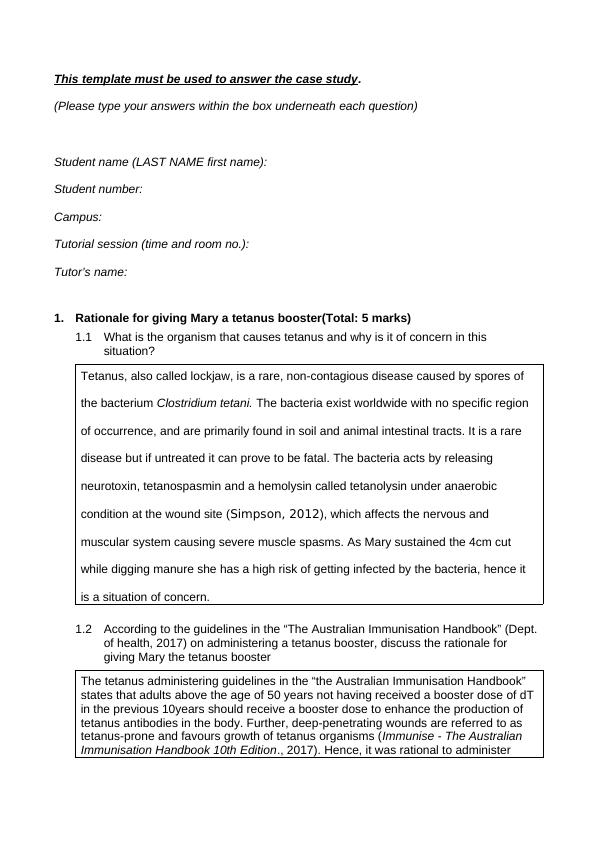The Australian Immunisation Handbook | Study
7 Pages2030 Words118 Views
Western Sydney University
Added on 2020-03-04
The Australian Immunisation Handbook | Study
Western Sydney University
Added on 2020-03-04
ShareRelated Documents
This template must be used to answer the case study. (Please type your answers within the box underneath each question)Student name (LAST NAME first name):Student number:Campus:Tutorial session (time and room no.):Tutor’s name:1.Rationale for giving Mary a tetanus booster(Total: 5 marks)1.1What is the organism that causes tetanus and why is it of concern in this situation? Tetanus, also called lockjaw, is a rare, non-contagious disease caused by spores of the bacterium Clostridium tetani. The bacteria exist worldwide with no specific region of occurrence, and are primarily found in soil and animal intestinal tracts. It is a rare disease but if untreated it can prove to be fatal. The bacteria acts by releasing neurotoxin, tetanospasmin and a hemolysin called tetanolysin under anaerobic condition at the wound site (Simpson, 2012), which affects the nervous and muscular system causing severe muscle spasms. As Mary sustained the 4cm cut while digging manure she has a high risk of getting infected by the bacteria, hence it is a situation of concern. 1.2According to the guidelines in the “The Australian Immunisation Handbook” (Dept. of health, 2017) on administering a tetanus booster, discuss the rationale for giving Mary the tetanus boosterThe tetanus administering guidelines in the “the Australian Immunisation Handbook” states that adults above the age of 50 years not having received a booster dose of dTin the previous 10years should receive a booster dose to enhance the production of tetanus antibodies in the body. Further, deep-penetrating wounds are referred to as tetanus-prone and favours growth of tetanus organisms (Immunise - The Australian Immunisation Handbook 10th Edition., 2017). Hence, it was rational to administer

tetanus to Mary. 2.Physiological basis of the three wound observations (Total: 10 marks) 2.1For each of the three wound observations indicate, and provide a rationale, as to whether it is a sign or a symptom.Although signs and symptoms are two terms often used synonymously in medical science, yet there is a distinct difference between them in clinical terms. Symptoms can only be described by the person suffering from the same that is the patient’s experiences of a disease for example dizziness, numbness, light-headedness, fatigues, visions disturbances etc. On the other hand, signs are physical manifestationof the effects of the disease and are observed by other especially the physician for example bleeding, bruising, swelling, fever etc. (Kraft & Keeley, 2015). Signs are objective in nature while symptoms are subjective in nature. Hence, in the given case study all the three observations, wound edges red and hot to touch, surrounding tissue swollen and purulent and odorous discharge respectively are all signs of a clinical condition. 2.2Discuss the physiological basis of the first observation.The natural bodily response to tissue injury is inflammation of the injured part, which includes both vascular and cellular responses. The first observation in Mary is wound edges are red and hot to touch. Tissue injury activates several chemical mediators like histamine, serotonin and complement system which cause substantial dilatation of the blood vessels to increase blood flow and leakage of serous fluid into the adjacent areas (Kalodiki et al., 2012). The increased blood supply makes the region red and transports immune cells such as leukocytes and antibodies to fight foreign particles. Due to increased blood supply the inflamed part acquires the core temperature of the body and feels warm to touch.

2.3Discuss the physiological basis of the second observation.As the blood vessels dilate during inflammation, it becomes more permeable to white blood cells, nutrients and hormones which move into the interstitial space between cells. Thus fluid carrying the inflammatory cells diffuses into the injured area and cause swelling.2.4Discuss the physiological basis of the third observation.Purulent and odorous discharge is a sign of unhealthy wound and requires immediatetreatment. Although some amount of exudate is normal in early inflammation, heavy and odorous discharge indicates the presence of growing bacterial contamination, as the body attempts to fight the same by maintaining a moist environment containing serum derivatives, proteins and inflammatory cells.

End of preview
Want to access all the pages? Upload your documents or become a member.
Related Documents
Tetanus and Organism | Case Studylg...
|5
|1821
|419
PHA7061-C - Cause of Tetanus - Question Answerslg...
|9
|2348
|237
Tetanus | Answer to Questionslg...
|6
|1573
|411
Organism and Tetanus Assignmentlg...
|5
|2139
|1131
Nursing Related Questions and Answerslg...
|8
|1683
|416
(PDF) Clostridium tetani as a pathogenic organismlg...
|5
|1814
|193
